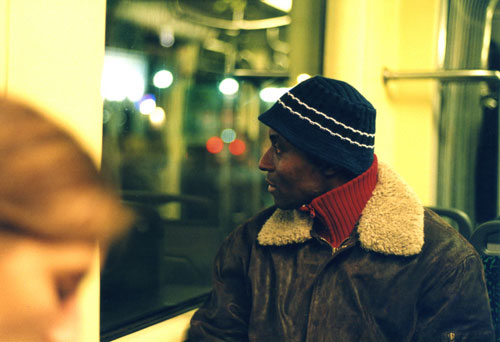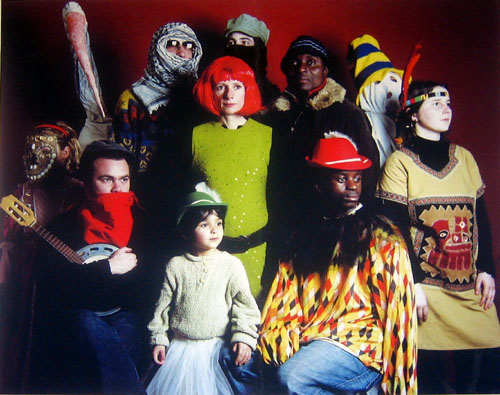| |
| |  |
MANMUSWAK
Film, 16', 2005, 35mm, DVD projection in the gallery. | | | | | | |
MANMUSWAK
April
28 - July 30 2005 |
| |
|
| |
| |
MANMUSWAK
Man must walk, it is certainly
necessary that man live, or rather man-must-live, according to the French translation
of Sozaboy, the novel by the Nigerian author Ken Saro Wiwa from which the title
of this film is taken. In fact, our man does walk : from an outlying neighbourhood,
a city enclave where he shares a room in shifts, through a wasteland ; on the
streets of the city centre, in the aisles of a shopping mall ; along the paths
of the botanical garden, on an avenue, at night. The town is thus surveyed ; he
takes measure of it, squares it off, lives it according to the movements that
his replacements require.
Because it is necessary for man to live and,
in order to do so, he accepts jobs that have nothing to do with his training or
level of qualifications. People from the Ivory Coast have a term that describes
the work of these migrants : djossi, which means “to sweep” and which
dates from the time when Africans in France were principally employed in road
maintenance. Watchmen, guards, bouncers and other security related jobs nowadays
seem to be djossi jobs. Paradoxically perhaps, it is precisely those persons,
whose legal presence in the country falls under the suspicion of the authorities,
who are systematically employed to guard private frontiers.
However, the
principle of the relay (between people that he occasionally replaces in their
guard posts) practised by the character K, gives him the opportunity to establish
“unusual links on a much greater geographical scale that are also socially
differentiated”, according to the places he guards and the relationships
that he maintains with the population who frequent them, and which “ turn
him into a weaver of social networks, a craftsman of the multitude, who opens
new perspectives: the links of the great socio-economic network do not only pass
through white collar workers and businessmen.”
In this sense, he
is reminiscent of “Homo Corona, Homme Ring”, the central figure of the
first episode of “Quelques K de mémoire vive”, the story of Patrick
Bernier's life recounted at the gallery by Carlos Ouédrago in July and
November 2003 (the present exhibition will be an opportunity to hear the second
episode of this story centred on his participation in the curatorial experiment
“ I Am A Curator”, directed by Per Hüttner at the Chisenhale Gallery
in London in November 2003).
Because of the way K moves around and the
exchanges of identity to which he must comply, Manmuswak is also reminiscent of
previous research undertaken by Olive Martin such as the film “Loop”,
in which different actors and actresses took on the role for one-shot of the same
couple going round a block in Chicago, or the photographic series “Patrick(s)
Bernier(s)” that is composed of portraits of homonyms.
The
film is made up of ambiguous sequences - as were the images of the psychological
test set up by Olive Martin in the series “Après le TAT” - which
let the spectator form his own interpretation. Consequently, we did not want it
to appear as a fiction, nor as a documentary but rather as the concentration of
semi-lived and semi- projected stories, in other words, as a fiction about the
life lived by these people and a documentary about our way of perceiving them.
The
film “MANMUSWAK” was produced by the Groupe de Recherche et d'Essai
Cinematographique (GREC), with the participation of the Délégation
aux Arts Plastiques (Fonds Images / Mouvement), the Fonds d'Action et de Soutient
pour l'Intégration et de Lutte contre les Discriminations (FASILD), Région
Pays de la Loire, Association Tissé Métisse - Nantes, Du Fresnoy
- Studio National des Arts Contemporain, and the Maisonneuve Gallery.
|
| |
| |
| |
| |
| |
MANMUSWAK
Film,
16', 2005, 35mm, présenté sous format DVD à la galerie.
Man
must walk, l'homme doit marcher, il faut bien que l'homme vive, ou bien encore
l'Homme-doit-viver, selon la traduction française de Sozaboy, le roman
de l'auteur nigérian Ken Saro Wiwa duquel est tiré le titre de ce
film. De fait, notre homme marche : depuis un quartier périphérique,
cité-enclave où il partage une chambre dans une tour, à travers
un terrain vague ; dans les rues du centre-ville, dans les rayons d'un centre
commercial ; dans les allées du Jardin des Plantes ; sur une avenue, le
soir. La ville est ainsi arpentée ; il en prend la mesure, la quadrille,
la vit au gré des déplcements que ses remplacements nécessitent.
Car il faut bien que l'homme vive : et pour vivre, il accepte des emplois qui
ne correspondent en rien à sa formation et à son niveau de qualification.
Les ivoiriens ont un terme pour qualifier le travail de ces émigrés
: djossi, qui signifie balayer et date du temps où les africains en France
étaient principalement employés dans l'entretien des voiries. Vigile,
gardien, videur et autres emplois ressortissant à la sécurité,
semblent être de nos
jours de ces emplois djossi. Apparent paradoxe que
soient systématiquement employées aux postes de contrôles
de frontières privées, des personnes dont nos autorités soupçonnent
tout aussi systématiquement la situation régulière sur le
territoire.
Cependant, le principe de relais (entre les personnes qu'il
remplace occasionnellement dans leur poste de vigile) que pratique notre personnage,
K, lui donne l'occasion d'établir "des liens inhabituels et sur une
échelle géographique plus vaste, mais aussi socialement différenciés",
selon les lieux qu'il garde et les relations qu'il entretient avec la population
qui les fréquente, et "fait de lui, un tisseur du réseau social,
un artisan de la multitude, qui ouvre des perspectives nouvelles : les liens du
grand réseau socio-économique ne passent pas uniquement par les
travailleurs cognitifs et les hommes d'affaire.".
En ce sens, il fait
écho à l' « Homo Corona, Homme Ring », figure centrale
du premier épisode de « Quelques K de mémoire vive »,
récit de vie de Patrick Bernier conté à la galerie par Carlos
Ouédraogo en juillet et novembre 2003 (la présente exposition sera
l'occasion de donner à entendre le deuxième épisode de ce
récit centré sur sa participation à l'expérience curatoriale
« I Am A Curator », menée par Per Hüttner à la
Chisenhale Gallery à Londres en novembre 2003).
Manmuswak fait également
écho, notamment dans la manière dont y circule K. et les échanges
d'identité auxquels il doit se plier, aux précédentes recherches
d'Olive Martin comme, par exemple, son film, « Loop », dans lequel
différents acteurs et actrices endossaient le temps d'un plan, le rôle
d'un même couple circulantautour d'un block à Chicago, ou sa série
photographique « Patrick(s) Bernier(s) », composée de portraits
|
| |
| |
| |
| |
 | Olive Martin
Karnaval, 2005
Color photography, poster, mounted on a "dos bleu"
65 x 80 cm / 25,6 x 31,5 inches |
| |
| |
| | | | .jpg) | Patrick Bernier
Transat Nord/Sud, 2004
transat conversation folding and reclining
beech wood and canvas | | |
| | | | |